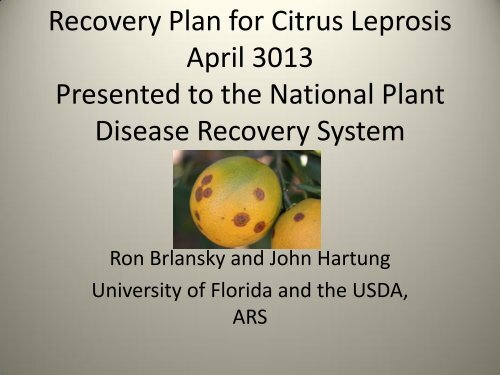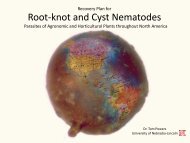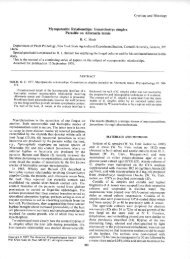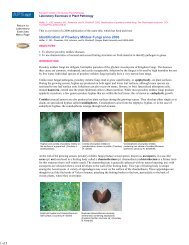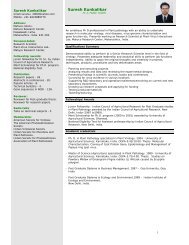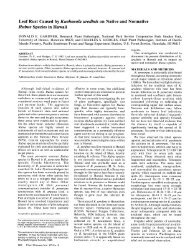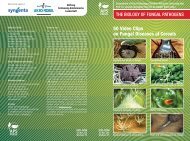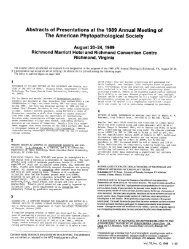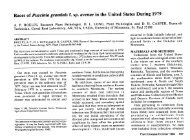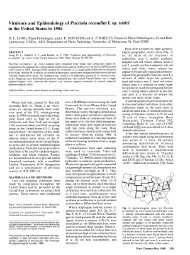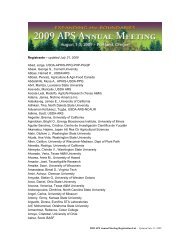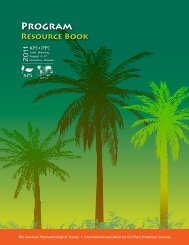Create successful ePaper yourself
Turn your PDF publications into a flip-book with our unique Google optimized e-Paper software.
Recovery Plan for <strong>Citrus</strong> <strong>Leprosis</strong><br />
April 3013<br />
Presented to the National Plant<br />
Disease Recovery System<br />
Ron Brlansky and John Hartung<br />
University of Florida and the USDA,<br />
ARS
Introduction<br />
• first reported from Florida in the early 1900’s<br />
• First called scaly bark because of stem lesions<br />
and bark scaling<br />
• Also named nail head rust because of the<br />
typical lesions on the fruits and stems<br />
• In 1926, the disease was called leprosis by<br />
Fawcett and Lee
• Disappeared in Florida in the 1960’s: why?<br />
• A freeze, intensive sulfur application reducing<br />
the vector populations and thus completely<br />
eliminating virus inoculum
Symptoms<br />
• Chlorotic leaf lesions becoming brown with or<br />
without necrotic centers<br />
• On leaves and twigs may become flat or<br />
slightly raised necrotic areas on twigs and<br />
leaves<br />
• On fruit lesions flat or depressed lesions with<br />
concentric patterns and gumming<br />
• With abundant lesions abscission of fruit and<br />
leaves can occur
• Twig dieback may happen due to extensive<br />
lesion development<br />
• Lesions on large limbs may coalesce and cause<br />
dieback; may resemble bark scaling similar to<br />
citrus psorosis
Host Range<br />
• Primarily on sweet orange<br />
• Mandarins and sour orange are susceptible<br />
but other citrus cultivars may not show<br />
symptoms<br />
• Transmissible to noncitrus species via<br />
mechanical transmission e.g. Gomphrena,<br />
Chenopodium with local lesions
Geographical Distribution<br />
• Previously found in Florida but apparently was<br />
eliminated<br />
• South America: Brazil, Argentina, Colombia,<br />
Venezuela, Bolivia, Paraguay, Uruguay<br />
• Central America: Panama, Guatemala, Costa<br />
Rica, Nicaragua, El Salvador, Belize<br />
• Mexico in 2005: now detected in 3 areas
Types of <strong>Leprosis</strong> (Virions)<br />
• In 1975 Kitajima found short rod virions 35-40<br />
x 120-130 nm in the nuclei of symptomatic<br />
leaf tissues<br />
• <strong>Virus</strong> tentatively identified as a naked<br />
rhabdovirus (CiLV-N)<br />
A<br />
CW<br />
NM<br />
N<br />
M<br />
B<br />
NI<br />
V
Cytoplasmic <strong>Citrus</strong> <strong>Leprosis</strong>:CiLV-C<br />
• Other particles also seen: 50-55 x 120-130 nm<br />
in the endoplasmic reticulum in the cytoplasm
Movement or Spread<br />
• 1999: reported in Venezuela<br />
• 2000: it had reached Panama and Costa Rica<br />
in Central America; virus on the move<br />
• 2005: CiLV-C reported in Mexico and in<br />
Colombia
CiLV-C Detection<br />
• 2004-2008: Molecular characterization and<br />
development of a rapid diagnostic methods<br />
for CiLV-C from Panama<br />
• 2006: Complete nucleotide sequence for<br />
CiLV-C from Brazil<br />
• 2008: CiLV-C on the move in Central America
CiLV-C<br />
CiLV-C is a bipartite positive sense RNA virus.<br />
Isolates from Brazil and Panama have been<br />
sequenced<br />
A rapid diagnostic method using PCR can be used<br />
to detect the cytoplasmic-type of leprosis and<br />
distinguish from the nuclear type<br />
Antibody detection systems have been developed
Transmission (CiLV-C and CiLV-N)<br />
• Graft transmitted with difficulty from<br />
symptomatic tissue (cleft grafts)<br />
• Transmitted by Brevipalpus flat mites. B.<br />
phoenicis larvae transmit after 24 h access<br />
period: nymphs and adults are less efficient ?<br />
• No transovarial mite transmission found<br />
• Spreads to new areas with infected trees and<br />
mites
Brevipalpus yothersi (synonym of<br />
B. phoenicis)
Hosts of the Mite<br />
• B. phoenicis:<br />
• reported over 65 hosts in 1958, but in 2004<br />
there may be 1,000 hosts. Hosts from Florida<br />
include: Gardenia, grapefruit, hibiscus, holly,<br />
ligustrum, lemon, lime, orange, pecan, and<br />
viburnum.
B. californicus Host Plants<br />
• Acacia, Acer, Acineta, Allamanda, Anguloa, Anthurium,<br />
Antidesma, Aphelandra, Bletia, Brassia, Callicarpa,<br />
Callistemon, Calycanthus, Catasetum, <strong>Citrus</strong>, Clausena,<br />
Clerodendrum, Cocos, Codiaeum, Columnea, Cordia,<br />
Cupressus, Crescentia, Croton, Dendrobium, Dodonaea,<br />
Dolichos, Epidendrum, Euphorbia, Ficus, Flacourtia,<br />
Flaveria, Gardenia, Gongor, Hibiscus, Houlletia, Howea,<br />
Ilex, Jacaranda, Ligustrum, Liquidambar, Lycaste,<br />
Magnolia, Malus, Melia, Odontoglossum, Peristeria,<br />
Persea, Pilea, Podocarpus, Poinsettia, Rhododendron,<br />
Sida, Solanum, Stantropea, Tabebuia, Thea, Thunbergia,<br />
Trevesia, Trichophila, Vitis, Wisteria.
Newly Discovered CiLV-C from Colombia in<br />
2012<br />
A<br />
New CiLV-C2 from Colombia
CiLV-C2 Summary<br />
• High-throughput sRNA sequencing identified an<br />
unknown new bipartite, positive sense single stranded<br />
RNA virus<br />
• The structure of CiLV-C2 genome resembled that of CiLV-<br />
C except that it contained a long 3′ UTR and an extra ORF<br />
(p7) in RNA2.<br />
•RNA1 and RNA2 of the CiLV-C2 had only 58% and 49%<br />
nucleotide identities with CiLV-C type<br />
•Phylogenetic analysis revealed close relatedness with<br />
CiLV-C t and placed the new virus as 2 nd member of<br />
Cilevirus genus<br />
26
Detection<br />
•CiLV-C2 specific primer pair was designed<br />
for RT-PCR & successfully identified and<br />
differentiated from CiLV-C type<br />
•Continuing developing antibodies<br />
(polyclonal & monoclonal) to expressed viral<br />
proteins for detection<br />
27
Nuclear <strong>Leprosis</strong>: CiLV-N<br />
• Nuclear CiLV (virions in nucleus CiLV-N)<br />
• Deep sequencing done and sequences<br />
analyzed<br />
• Identification pending<br />
• Also Hibiscus green spot virus sequenced<br />
in Hawaii also detected in rough lemon<br />
citrus with symptoms similar to leprosis<br />
• Currently 4 different viruses causing<br />
leprosis symptoms
Economic Impact<br />
• No hard economic figures on fruit lost, lost markets,<br />
tree decline<br />
• <strong>Leprosis</strong> has been a serious disease of citrus in Brazil<br />
and Argentina since 1930s<br />
• Cost to live with leprosis: 21% increase in production<br />
cost;12 extra acaricide sprays per yr.<br />
• Est. $75-100 million is spent on controlling the mites<br />
in Brazil (35% chemical costs)<br />
• The disease has spread into Central America
Recovery Plan<br />
• Strict quarantine measures should remain in place at<br />
all ports of entry for production citrus, ornamental<br />
citrus, and any ornamental plants or weeds that are a<br />
host to the leprosis viruses or its mite vectors,<br />
especially those originating from South America.<br />
Studies should be considered to identify all hosts and<br />
the specific mite species that are vectors.<br />
• Develop and deploy molecular and serological tests<br />
that distinguish among the various forms of <strong>Citrus</strong><br />
leprosis virus
• Monitor citrus groves and commercial nurseries,<br />
including distributors that market to homeowners<br />
for symptoms of leprosis<br />
• Test acaracide products and treatment schedules to<br />
validate control programs for Florida, Texas and<br />
California<br />
• Education is needed for all plant pathologists, plant<br />
health professionals, extension agents, nursery<br />
growers, retailers etc to raise awareness of<br />
potentially invasive citrus leprosis.
• Understand the epidemiology of the disease,<br />
especially the roles and interactions of mite vectors<br />
with the virus and with citrus and other hosts.<br />
• Active pursuit of methods to manage this disease<br />
upon introduction is essential in order to avoid the<br />
economic consequences experienced by other<br />
countries.
References<br />
• Kitajima, E. W., Müller, G. W., Costa, A. S., and Yuki, W. 1972. Short, rodlike<br />
particles associated with citrus leprosis. Virology 50:254-258.<br />
• Leon M., G. A., Realpe, C. E., Garzon, P. A., Rodriguez, J. A., Moreno P., M.<br />
G., Childers, C. C., Achor, D., Freitas-Astúa, J., Antonioli-Luizon, R., Salaroli,<br />
R. B., Cobo, N. C. M., and Kitajima, E. W. 2006. Occurrence of <strong>Citrus</strong><br />
leprosis virus in Llanos Orientales, Colombia. Plant Dis. 90:682.<br />
• Bastianel, M., Novelli, V.M., Kitajima, E.W., Kubo, K.S., Bassanezi, R.B.,<br />
Machado, and M.A., Freitas-Astua, J., 2010. <strong>Citrus</strong> <strong>Leprosis</strong>: Centennial of<br />
an Unusual Mite <strong>Virus</strong> Pathosystem. Plant Dis., 94:284-292.<br />
• Roy, Avijit, Choudhary, Nandlal, Leon, G. A. , Achor, Diann, Shao, Jonathan,<br />
Nakhla, Mark Hartung, John S., Levy, L. nd R. H. Brlansky. 2013.<br />
Identification of a new citrus cytoplasmic virus associated with citrus<br />
leprosis disease in Colombia using deep sequencing. Phytopathology<br />
103:488-500.


